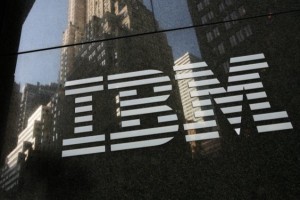 Still hampered by slow hardware sales, IBM reported a 5.5 percent decline in revenue for the fourth quarter, even as it managed to post a 6 percent gain in net income.
Still hampered by slow hardware sales, IBM reported a 5.5 percent decline in revenue for the fourth quarter, even as it managed to post a 6 percent gain in net income.
Because of the sluggish revenue, IBM senior management will forgo their bonuses for the year, said Ginni Rometty, President and CEO, IBM.
IBM’s fourth-quarter revenue was US$27.7 billion, compared with $29.3 billion in the fourth quarter of 2012, the company announced Tuesday. IBM’s revenue fell short of analysts’ expectation of $28.2 billion, an estimate provided by Thomson Reuters. Revenue for the entire year was $99.8 billion, compared with $104.5 billion in the previous year, a 4.6 percent decrease.
IBM’s fourth-quarter income was $6.2 billion, compared with $5.8 billion in the fourth quarter of 2012. For the year, IBM reported $16.5 billion in income, down 1 percent from $16.6 billion in the prior year.
Revenue from IBM’s Systems and Technology hardware segment was $4.3 billion, down 26 percent from the fourth quarter in 2013. For the year, Systems and Technology delivered $14.4 billion, a decrease of 18.7 percent from the full year 2012.
The services divisions produced hit-and-miss results for the company. Revenue from Global Technology Services was $9.9 billion for the quarter, down 3.6 percent from $10.3 billion the same quarter a year before. Revenue from the Global Business Services segment grew slightly, up 0.6 percent to $4.7 billion for the fourth quarter, which ended 31st December.
For the year, Global Technology Services revenue shrank to $38.5 billion, down 4.2 percent from $40 million the year before. Global Business Services revenue also shrank by 0.9 percent, to $18.4 billion from $18.6 billion a year ago.
Revenue from the software business grew modestly. For the fourth quarter of 2013, the software group logged $8.1 billion in revenue, a 2.8 percent increase from $7.9 billion in the same quarter a year ago. For the year, the IBM software group generated $26 billion in revenue, up 1.9 percent from $25.4 billion in 2012.
“Our software, services and financing businesses are all on solid ground, but in hardware, we’ve entered the back-end mainframe product cycle, and we are dealing with some challenges in other areas. These are impacting our overall results,” said Martin Schroeter, IBM chief financial officer, in a webcast to investors.
With hardware, IBM was plagued in a number of areas. System Z and mainframe sales were down because they are in-between product releases. Other areas of hardware are feeling the impact of “business model issues due to market shifts,” some of which is coming from pricing pressure from lower-cost hardware alternatives, Schroeter said.
System Z sales were down 37 percent, when compared to a very strong quarter a year ago. Sales of MIPS (Microprocessor without Interlocked Pipeline Stages) mainframe systems declined 26 percent, also compared to a very strong quarter a year ago. Sales of Power systems declined 31 percent. While the company continues to ship Power systems, the greater efficiency of the newer systems reduces the size of the systems being shipped, lowering revenue for IBM, Schroeter said. System X sales were down 15 percent.
Pure systems, a new offering introduced last year, provided one bright spot on the hardware side. IBM shipped more than 2,500 Pure systems in the past quarter, and 10,000 since launch.
Another area of concern for IBM has been sales in China, which declined by 23 percent, chiefly in hardware sales.
A large part of this decline came from a broad-reaching Chinese government economic reform initiative, which has stalled state agency IT purchases. This initiative also slowed sales in IBM’s last quarter as well.
“While there is more clarity in the overall plan, we continue to believe it will take some time for business in China to improve,” Schroeter said.
In contrast, revenue in Japan grew by 4 percent, and has grown for the past five quarters. Schroeter attributed this success to IBM’s capability to shifting market focus and investment to meet current needs in IT.
In the past few weeks IBM announced two major initiatives. The company plans to invest an additional $1.2 billion to beef up its cloud infrastructure. It has also launched a new business group focused on providing Watson-style cognitive computing capabilities to help organisations make better use of their large amounts of data.
The company is planning on both initiatives to lead to substantial business over time.
“We believe that data as a natural resource will drive demand going forward, and big data analytics will provide the basis for competitive differentiation,” Schroeter said.
Data analysis is now “nearly a $16 billion” annual business for the company, he said. Cloud business accounts for $4.4 billion in revenue for the company, of which $1.7 billion was delivered as a cloud service.
IBM continued to perform well for investors. This quarter, the company posted earnings per share of $5.73, a 12 percent increase over EPS of $5.13 for the fourth quarter of 2012. For the year, earnings were $14.94 per share compared with $14.37 per share in 2012, a 4 percent increase.
The company is still on track to reach $15 per share by 2015, Schroeter said.





